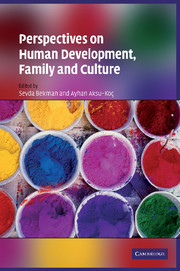Book contents
- Frontmatter
- Contents
- List of figures
- List of tables
- List of contributors
- Preface
- Foreword
- Selected international publications by Çiğdem Kağıtçıbaşı
- I Cultural and cross-cultural psychology: selected perspectives
- II Development in the family context
- III Culture and self
- 9 In search of autonomous-relational self-construal
- 10 Culture and developmental pathways of relationship formation
- 11 Microgenesis of narrative competence during preschool interactions: Effects of the relational context
- 12 Self-development, individuation, and culture: A psychoanalytic search
- IV Social change, family, and gender
- V Induced change
- Epilogue
- Subject Index
- Author Index
- References
11 - Microgenesis of narrative competence during preschool interactions: Effects of the relational context
Published online by Cambridge University Press: 04 August 2010
- Frontmatter
- Contents
- List of figures
- List of tables
- List of contributors
- Preface
- Foreword
- Selected international publications by Çiğdem Kağıtçıbaşı
- I Cultural and cross-cultural psychology: selected perspectives
- II Development in the family context
- III Culture and self
- 9 In search of autonomous-relational self-construal
- 10 Culture and developmental pathways of relationship formation
- 11 Microgenesis of narrative competence during preschool interactions: Effects of the relational context
- 12 Self-development, individuation, and culture: A psychoanalytic search
- IV Social change, family, and gender
- V Induced change
- Epilogue
- Subject Index
- Author Index
- References
Summary
I examine socialization for competence, not only from the point of view of the child developing cognitive skills but in terms of the total interactive process of teaching and learning in cultural context and the meaning attributed to it by all those involved.
(Kağıtçıbaşı 2007: 60)Çiğdem Kağıtçıbaşı was an influential socializing agent leading to my entry into psychology as my chosen field. As she is a long-term family friend, the topic of her emergence as a foremost social scientist in the world often blossomed in our dinnertime talk. When I wanted to switch from another field to psychology, her encouraging words exhilarated me and comforted my family. In fact, she was the one to call and inform me that my transfer to psychology has been approved. I remember that bath-robed moment of my life vividly, where my mother rushed me out from a shower to accept that personally momentous call from Çiğdem. Over the following years, I learned a lot from her both as a student and a colleague. I am honored to have the opportunity to deliver the following piece of work, which owes much to her guidance and encouragement, in celebration of her theoretical and applied contributions to socialization of children into competent beings.
Self-stories derived from autobiographical memory and how children develop these cognitive/linguistic structures have been a focus of intensive interest in the last two decades. The work on children's narrative competence stems from at least three lines of concern: (1) Narratives as indicators of self-development.
- Type
- Chapter
- Information
- Perspectives on Human Development, Family, and Culture , pp. 178 - 193Publisher: Cambridge University PressPrint publication year: 2009
References
- 1
- Cited by



